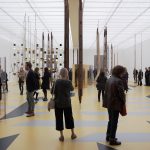Ohne Haut Ohne Haus (without skin, without house) is a group exhibition at Akku Kunstplattform Emmen in Emmenbrücke (near Lucerne, Switzerland). The exhibition is the last part of a series of exhibitions curated by Claudia Waldner. Third exhibition deals with empty spaces and places; houses without people and people without houses. Here, topics such as feelings of home are linked to a place. It is about localization as well as border (dissolving) and homelessness.
Ohne Haut Ohne Haus. Group Exhibition at Akku Kunstplattform Emmen. Selected artists: Judith Albert, Marco Baltistberger & Timo Ullmann, Silvia Bächli & Eric Hattan, Ruth Baettig, Eva Borner, Ishita Chakraborty, Lea Fröhlicher & Olivia Hegetschweiler, Sabine Hertig, Ursula Palla. Raum: Otto Heigold. Curated by Claudia Waldner. The exhibition runs until October 29, 2023.
Ohne Haut Ohne Haus. Group Exhibition at Akku Kunstplattform Emmen. Emmenbrücke (near Lucerne, Switzerland), August 21, 2023. Introduction by Claudia Waldner (in German language, transcript / English translation below).
> Right-click (Mac: ctrl-click) this link to download Quicktime video file.
Transcript / translation: We are now in the “akku”, in the art platform in Emmenbrücke. I was a guest curator there in 2023 and was allowed to conceive and implement a three-part exhibition concept with the overall title “Haut Haus” (skin house). The first exhibition, which took place in the spring, a group exhibition with nationally known artists, dealt with the skin, i.e. the organ and the protective function of our skin, the shell, in a very poetic way. It was actually an examination of the innermost being. With “Haus” (house), in the second exhibition shortly before the summer, it was really about the house and not about our houses in general, but it was about this place here, about this wonderful hall in this “Viscose” area, about this “akku” art platform and this place and this space, but also about dealing with such a place in the art context: So cultural-political topics were discussed, like the change in art, maybe, participation was also a topic and actually also the artistic creation in the process. A group of artists lived here in the places and in the rooms here, actually around the clock, and incorporated the system with their system. There were real principle and system discussions about the market, about money and art and the world.
Out of the “House” exhibition we are now in the last in a series of three and it has the main title “ohne Haut ohne Haus” (without skin without house). This exhibition, which is again a group exhibition with nationally known artists from Switzerland, is about the location of man in the overall system of the world. Humans will always be marginally visible or perceptible, but they are never really dominant. You can hear it here in the background, you almost feel like you’re in a Masoala hall, active, at the moment, it’s still warm, the crickets. So it’s a lot about nature and cosms and macro- and micro-cosms, about the immersion of the human being in the overall structure. But also the movement, the flight plays a big role, the migration, being alone, not being at home, walking on the street, leaving borders, crossing, skipping, whatever. It is also about an inner regulation of one’s own homelessness or the feeling of being at home, but it is also about completely detaching yourself from what is close inside and far, far, far out of this space, looking at the planet from a distance and the greatness of the human being in it to become aware of the overall structure.
Yes, I am very happy about this exhibition. It is a successful conclusion to the series of three, not an end to the topic itself, the topic will probably accompany mankind for millions of years to come. It’s wonderful for me to end the series with this. There is a small publication summarizing all three exhibitions. It’s a wonderful, an exciting place. In this exhibition, when you come in, it actually begins with the place itself. It’s really about stories, experiences, memories from migration backgrounds. You then come to a poetic part of the exhibition, where you deal with the inner life and more so with this personal location in the world, with the view from the outside, as I said, and then ends with this tour of the exhibition, with a tour, So a kind of trail, art trail through Emmenbrücke, really great, up to a bus stop in the “Anders Wo” (elsewhere), the journey to the “Anders Wo”, this bus stop, also a meadow nearby. So you really step out of this exhibition context and you have arrived in the here and now.






